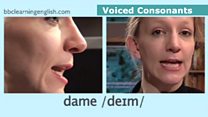Unit 8: Towards advanced
Grammar, news, vocabulary and pronunciation
Select a unit
- 1 Towards advanced
- 2 Towards advanced
- 3 Towards advanced
- 4 Towards advanced
- 5 Towards advanced
- 6 Towards advanced
- 7 Towards advanced
- 8 Towards advanced
- 9 Towards Advanced
- 10 Towards Advanced
- 11 Towards Advanced
- 12 Towards Advanced
- 13 Towards Advanced
- 14 Towards Advanced
- 15 Towards Advanced
- 16 Towards Advanced
- 17 Towards Advanced
- 18 Towards Advanced
- 19 Towards Advanced
- 20 Towards Advanced
- 21 Towards Advanced
- 22 Towards Advanced
- 23 Towards Advanced
- 24 Towards Advanced
- 25 Towards Advanced
- 26 Towards Advanced
- 27 Towards Advanced
- 28 Towards Advanced
- 29 Towards Advanced
- 30 Towards Advanced
Session 5
Tim's Pronunciation Workshop: Assimilation of /n/
Tim explains one reason why the sound /n/ sometimes changes to /m/.
Activity 1
Tim's Pronunciation Workshop: Assimilation of /n/ followed by /p/
It's Green Park
Tim's back in his pronunciation workshop. This time he's looking at an aspect of connected speech called assimilation of /n/ followed by /p/. Find out what it is, how to use it, and practise saying it yourself!
To do
Take a look at the video, then try the activity to do some practice.
Watch the video and complete the activity

Tim
Hi, I'm Tim and this is my pronunciation workshop. Here, I'm gonna show you how English is really spoken. It'll help you become a better listener and a more fluent speaker. Come on, let's go inside. Now, one of the things that happens when we speak fluently is that the sounds at the end of a word can change. To demonstrate this, we asked people on the streets of London to identify this Tube station.
Voxpops
Green Park
Green Park
Green Park
It's Green Park
Tim
Now, the word Green ends in the sound /n/, doesn't it? Or does it? Listen again, what sound can you hear?
Voxpops
Green Park
Green Park
Green Park
It's Green Park
Tim
So, what's happening here? Well, when one word ends in the sound /n/ and the next word begins with a /p/, /b/, /w/ or /m/ sound, then the /n/ from the end of the word changes to an /m/ sound as your mouth gets ready to pronounce the next sound. 'Green Park' becomes 'Greempark'. Watch again - this time in slow motion. Look at the mouth shape. Can you see /n/, or /m/?
Voxpops
Green Park
Green Park
Green Park
It's Green Park
Tim
Interesting, eh? This is called assimilation. Here are some more examples:
Examples
I own ten pairs of socks.
He didn't do it on purpose.
I would love to live in Paris.
Can you come on Wednesday?
Tim
Right, so you've heard the examples and now it's your turn. Are you ready? Listen and repeat.
Examples
I own ten pairs of socks.
He didn't do it on purpose.
I would love to live in Paris.
Can you come on Wednesday?
Tim
Well done. Now if you want to read more about pronunciation please visit our website: bbclearningenglish.com. That's about it from the pronunciation workshop for now. I'll see you next time. Bye bye. Now, where is Green Park - is it on Buckingham Palace Road? Aaaah!
To do
Got that? Now try this activity to get some more practice.
The /n/ game
6 Questions
How many examples of assimilation of /n/ followed by /b/, /p/, /w/ or /m/ are there in each sentence? You decide...
Help
Activity
How many examples of assimilation of /n/ followed by /b/, /p/, /w/ or /m/ are there in each sentence? You decide...
Hint
When a word ends in an /n/ sound and the next word begins with a /b/, /p/, /w/ or /m/, the /n/ at the end will change to an /m/ as your mouth gets ready to say the next sound.Question 1 of 6

Help
Activity
How many examples of assimilation of /n/ followed by /b/, /p/, /w/ or /m/ are there in each sentence? You decide...
Hint
When a word ends in an /n/ sound and the next word begins with a /b/, /p/, /w/ or /m/, the /n/ at the end often changes to an /m/ as your mouth gets ready to say the next sound.Question 2 of 6

Help
Activity
How many examples of assimilation of /n/ followed by /b/, /p/, /w/ or /m/ are there in each sentence? You decide...
Hint
When a word ends in an /n/ sound and the next word begins with a /b/, /p/, /w/ or /m/, the /n/ at the end often changes to an /m/ as your mouth gets ready to say the next sound.Question 3 of 6

Help
Activity
How many examples of assimilation of /n/ followed by /b/, /p/, /w/ or /m/ are there in each sentence? You decide...
Hint
When a word ends in an /n/ sound and the next word begins with a /b/, /p/, /w/ or /m/, the /n/ at the end often changes to an /m/ as your mouth gets ready to say the next sound.Question 4 of 6

Help
Activity
How many examples of assimilation of /n/ followed by /b/, /p/, /w/ or /m/ are there in each sentence? You decide...
Hint
When a word ends in an /n/ sound and the next word begins with a /b/, /p/, /w/ or /m/, the /n/ at the end often changes to an /m/ as your mouth gets ready to say the next sound.Question 5 of 6

Help
Activity
How many examples of assimilation of /n/ followed by /b/, /p/, /w/ or /m/ are there in each sentence? You decide...
Hint
When a word ends in an /n/ sound and the next word begins with a /b/, /p/, /w/ or /m/, the /n/ at the end often changes to an /m/ as your mouth gets ready to say the next sound.Question 6 of 6

Excellent! Great job! Bad luck! You scored:
End of Unit 8
We hope that was useful. In Unit 9, Sian brings you another English Masterclass - in this one, she'll be explaining how some verbs change their meaning depending on whether they are in the -ing or -ed form. In News Review and LingoHack you can find out which words are making the headlines - and Tim will be back with the pronunciation workshop as usual. See you there!
Session Vocabulary
Assimilation of /n/
When fluent speakers of English say a word that ends in the sound /n/, followed by a word that begins with a /p/, /b/, /w/ or /m/ sound, the /n/ often changes to an /m/ as the mouth gets ready to pronounce the next sound.Some examples of phrases where this might happen include:
- Green Park.
- I live in Paris.
- See you on Wednesday.


